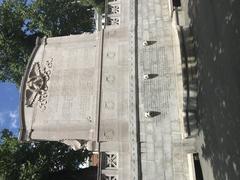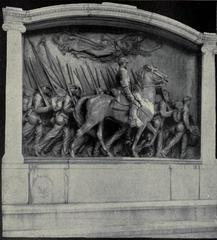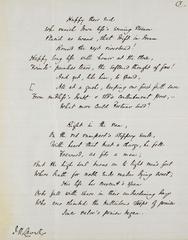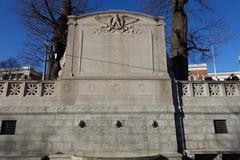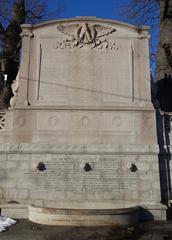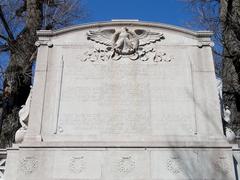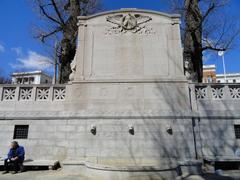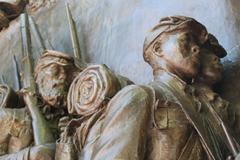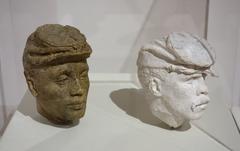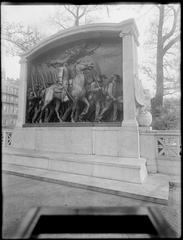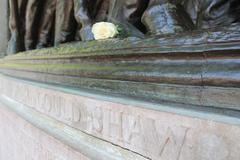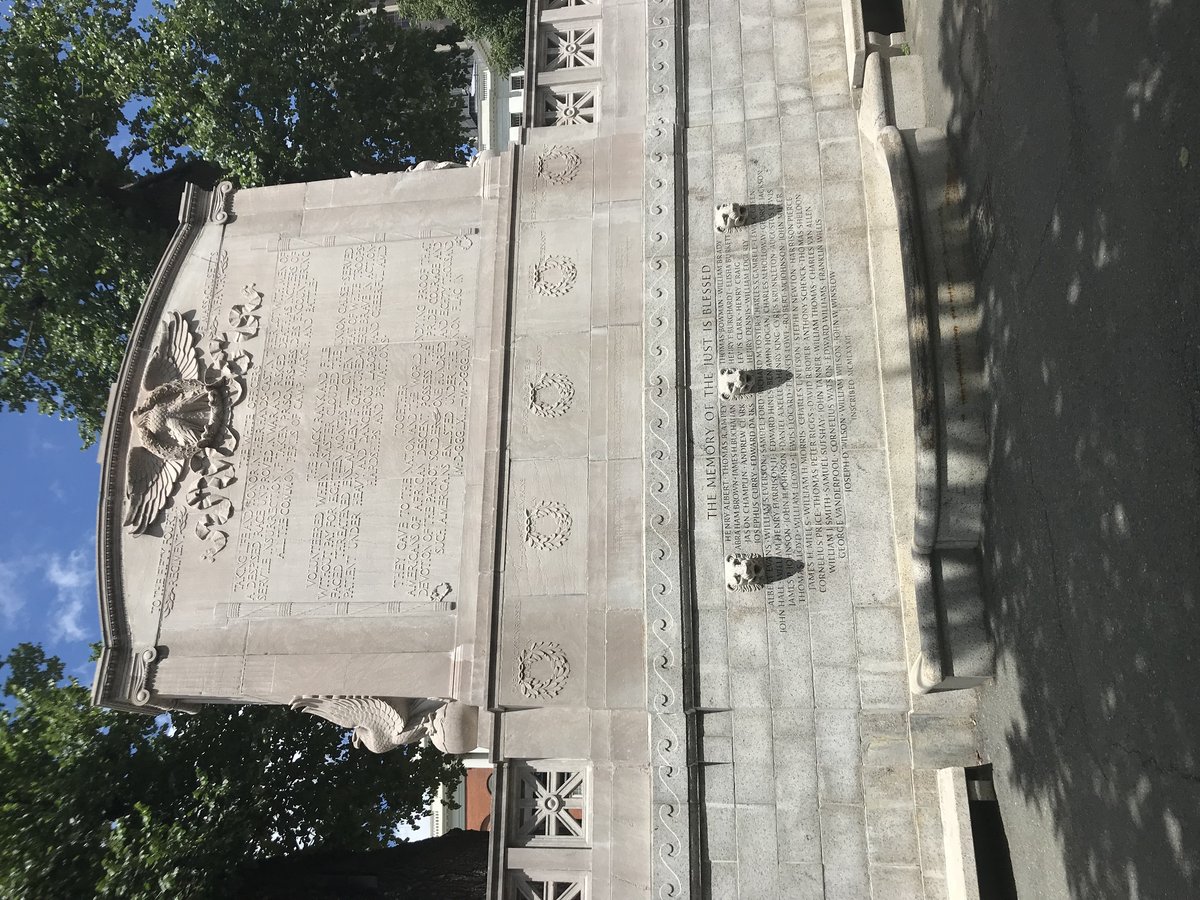
Memorial To Robert Gould Shaw And The Massachusetts Fifty Fourth Regiment
Visiting the Memorial to Robert Gould Shaw and the Massachusetts Fifty-Fourth Regiment in Boston: Hours, Tickets, and Travel Tips
Date: 15/06/2025
Introduction
The Memorial to Robert Gould Shaw and the Massachusetts Fifty-Fourth Regiment is a cornerstone of Boston’s historical landscape and a profound tribute to the struggle for freedom and equality in the United States. Located at the intersection of Beacon and Park Streets, directly facing the Massachusetts State House on Boston Common, this monument honors the first official African American regiment organized in the northern states during the Civil War. Whether you are a historian, art enthusiast, educator, or traveler, a visit to this landmark provides an enriching experience that combines art, history, and enduring themes of social justice (National Gallery of Art, NPS).
Table of Contents
- Origins and Historical Context
- The 54th Massachusetts Regiment: Formation and Legacy
- The Assault on Fort Wagner
- The Memorial’s Conception and Artistic Vision
- Visiting the Memorial: Hours, Tickets, and Accessibility
- Guided Tours and Nearby Attractions
- Preservation and Restoration
- Cultural Impact and Modern Relevance
- Frequently Asked Questions (FAQ)
- Visitor Tips and Practical Information
- Conclusion
- References
Origins and Historical Context
Following the Emancipation Proclamation in 1863, Massachusetts Governor John Albion Andrew responded to the call for African American participation in the Union Army by forming the 54th Massachusetts Regiment. The unit recruited African American men from across the North, many of whom saw military service as a path to freedom and citizenship (National Gallery of Art). Colonel Robert Gould Shaw, a young officer from a prominent Boston abolitionist family, was chosen to lead the regiment—a decision that underscored the intertwining of Boston’s abolitionist activism and the national struggle for civil rights.
The 54th Massachusetts Regiment: Formation and Legacy
The 54th Massachusetts Regiment was one of the first African American units in the Union Army, composed of volunteers who faced discrimination, unequal pay, and skepticism about their abilities. Their courage and discipline, both in camp and in battle, played a pivotal role in dispelling racist myths and encouraging the enlistment of nearly 200,000 Black soldiers in the Union forces by the end of the Civil War (Tour de Force DC, Wikipedia).
The Assault on Fort Wagner
On July 18, 1863, the 54th led the Union assault on Fort Wagner in South Carolina. Despite suffering heavy casualties—nearly half the regiment was killed, wounded, or captured—the 54th’s bravery became a symbol of Black military valor and inspired further African American enlistment. Colonel Shaw was killed in the battle, and his leadership and sacrifice are commemorated in the memorial (Friends of the Public Garden).
The Memorial’s Conception and Artistic Vision
Shortly after the war, Black and white abolitionists, including Joshua Bowen Smith and key civic leaders, advocated for a monument to the 54th and Colonel Shaw. After extensive fundraising and public debate, renowned sculptor Augustus Saint-Gaudens was commissioned in 1884. Over 14 years, Saint-Gaudens created an innovative bronze relief—measuring 11 by 14 feet—depicting Shaw on horseback leading 23 individually modeled African American infantrymen. The composition broke with artistic conventions by honoring both the officers and enlisted men, capturing their humanity and collective sacrifice (NPS, Wikipedia).
Above the regiment, an allegorical female figure floats, holding poppies and an olive branch—symbols of sleep, death, and peace—adding emotional depth to the work (National Gallery of Art).
The memorial was dedicated on May 31, 1897, with a procession of 54th veterans and a speech by Booker T. Washington, who emphasized the ongoing struggle for justice and equality (NPS).
Visiting the Memorial: Hours, Tickets, and Accessibility
- Location: Beacon and Park Streets, Boston Common, opposite the Massachusetts State House.
- Hours: Open 24 hours daily, year-round. The best viewing times are dawn to dusk.
- Tickets/Admission: Free; no tickets required (Boston Common Visitor Center).
- Accessibility: Wheelchair accessible with paved paths and ramps. The memorial is flat and easy to approach for all visitors.
- Transportation: The Park Street MBTA station is steps away (Red and Green Lines). Parking is available in nearby garages, though public transport is recommended (stepboston.com, nps.gov).
Guided Tours and Nearby Attractions
- Guided Tours: Available through the Boston Common Visitor Center, National Park Service, and local historical groups. The memorial is a highlight of the Freedom Trail and the Boston Black Heritage Trail (NPS).
- Self-Guided Tours: Brochures and audio guides can be accessed online.
- Nearby Sites: Massachusetts State House, Museum of African American History, Boston African American National Historic Site, Granary Burying Ground, and the entirety of Boston Common (Museum of African American History, stepboston.com).
Preservation and Restoration
The memorial has been carefully preserved, with major restorations—most recently in 2021—addressing both the bronze sculpture and granite frame. These efforts, led by the City of Boston, the National Park Service, and Friends of the Public Garden, ensure the monument’s longevity. Interpretive panels and digital resources now enhance visitor understanding (Friends of the Public Garden, WBUR).
Cultural Impact and Modern Relevance
The Shaw/54th Memorial has served as a site for commemorations, educational events, and civil rights gatherings. It inspired the acclaimed film “Glory” and continues to shape historical memory and public discourse on race and justice. Annual events, such as commemorations on May 28 and Juneteenth, draw descendants, veterans, and community members to honor the ongoing legacy of the regiment (WBUR, Gettysburg Daily).
Frequently Asked Questions (FAQ)
Is there an admission fee?
No, the memorial is free and open 24 hours daily.
Are guided tours available?
Yes, through the Boston Common Visitor Center and various historical organizations.
Is the site wheelchair accessible?
Yes, with paved walkways and ramps.
Where is the memorial located?
At the intersection of Beacon and Park Streets, facing the Massachusetts State House.
What is the best way to get there?
Public transportation is recommended. The Park Street MBTA station is a short walk away.
Can I take photos?
Absolutely; the memorial is a popular spot for photography, especially at sunrise and sunset.
Visitor Tips and Practical Information
- Best Times to Visit: Spring and autumn offer pleasant weather and beautiful surroundings (best-time.to). Early mornings and late afternoons provide optimal lighting for photos (questoapp.com).
- Combine with Other Sites: Explore the nearby Museum of African American History or join a Freedom Trail tour for a comprehensive historical experience (bostonsightseeing.us).
- Amenities: Restrooms and benches are available in Boston Common. Numerous dining and shopping options are within walking distance.
- Etiquette: Maintain a respectful and contemplative demeanor. This is a site of remembrance and reflection.
Conclusion
The Robert Gould Shaw and Massachusetts Fifty-Fourth Regiment Memorial is a profound testament to the courage, sacrifice, and enduring spirit of those who fought for freedom and equality. With its central location, free admission, and powerful history, it is an essential stop for anyone seeking to connect with Boston’s heritage and the continuing story of American civil rights. Plan your visit to this remarkable monument and explore the rich network of nearby historic sites for a deeper appreciation of the 54th Regiment’s legacy.
References
- National Gallery of Art
- National Park Service – Shaw Memorial
- Tour de Force DC
- Gettysburg Daily
- WBUR
- Step Boston
- Friends of the Public Garden
- Wikipedia
- Boston Common Visitor Center
- Museum of African American History
- Boston African American National Historic Site
- Boston Black Heritage Trail
